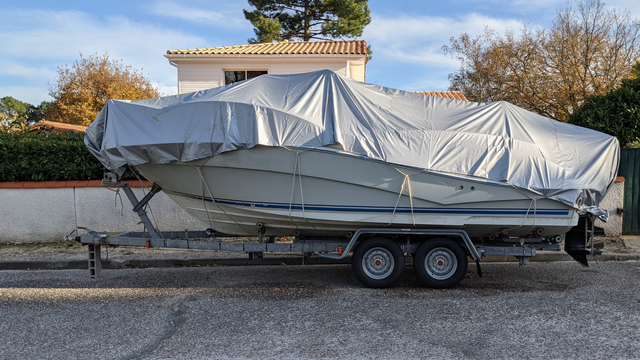How Boat Tarps Can Protect Against UV Rays and Fading
Boats are a major investment, whether used for fishing, recreation, or professional purposes. But one of the most overlooked threats to your boat’s longevity is something that’s ever-present: the sun. Prolonged exposure to UV (ultraviolet) rays can cause significant damage to your boat’s surfaces, from faded paint and brittle upholstery to cracked dashboards and weakened fiberglass. Fortunately, one of the most effective and affordable ways to guard against UV damage is by using a high-quality boat tarp.
In this blog, we’ll explore how UV rays affect boats, the benefits of using UV-resistant tarps, and what to look for when choosing the right cover to shield your investment from the sun.
1. Understanding UV Damage on Boats
UV rays from the sun break down molecular bonds in materials, a process known as photodegradation. On boats, this can lead to:
Faded paint and gel coats
Discoloration of vinyl seating
Cracking and drying of rubber and plastic components
Warping or weakening of fiberglass hulls
What starts as subtle fading can quickly lead to costly repairs or replacements. Even boats that spend most of their time on trailers or docks can suffer from intense sun exposure, especially during the summer months.
Additionally, the reflective nature of water intensifies UV exposure, making marine environments particularly harsh. Without proper protection, UV damage can drastically reduce your boat’s resale value and lifespan.
2. How UV-Resistant Boat Tarps Work
Not all tarps are created equal when it comes to UV protection. UV-resistant boat tarps are designed with treated coatings or fabrics that block harmful ultraviolet rays from penetrating the material. These treatments help prevent:
Sunlight from reaching sensitive surfaces
Heat buildup that can accelerate fading and cracking
Premature degradation of the tarp itself
The best UV-resistant tarps feature materials like polyethylene, vinyl, or acrylic that have been specifically treated to withstand prolonged sun exposure. These materials reflect or absorb UV radiation, acting as a shield that safeguards your boat’s finish and interior.
It’s important to note that even if a tarp appears thick or heavy-duty, that doesn’t automatically mean it’s UV-resistant. Look for tarps labeled with UV treatment or UV-stabilized to ensure effective sun protection.
3. Benefits of Using a UV-Protective Boat Tarp
Investing in a UV-protective tarp can deliver multiple long-term benefits, including:
Extended Lifespan of Surfaces
UV-resistant tarps reduce the risk of surface wear, extending the life of your boat’s paint, upholstery, and plastic components.Lower Maintenance Costs
With reduced fading, cracking, and damage, you’ll spend less on repairs, cleaning products, and replacements over time.Improved Appearance
A well-preserved boat looks better and holds its value longer. Tarps keep colors vibrant and surfaces smooth.Temperature Control
Many UV-blocking tarps also help regulate internal boat temperatures by reflecting heat—ideal for preventing interior damage during hot weather.All-Season Protection
Most UV-resistant tarps also offer protection against rain, wind, dust, and bird droppings, giving your boat 360-degree defense.
4. Choosing the Right UV-Resistant Tarp Material
When selecting a boat tarp specifically for UV protection, consider these top-performing materials:
Vinyl Tarps: Heavy-duty and extremely UV-resistant. Great for long-term outdoor use and high-sun environments.
Polyethylene Tarps: Lightweight and UV-treated options are available at a lower cost. Ideal for seasonal use.
Canvas with UV Treatment: Offers breathability with added sun resistance. Best for shaded or partially covered storage.
Acrylic-Coated Fabrics: Often used in marine environments for their resistance to UV, water, and mildew.
Check for features like double-stitched seams, reinforced corners, and grommets for secure tie-downs—these enhance the longevity and performance of your tarp.
Also, color matters. Lighter-colored tarps (white, silver, beige) reflect more sunlight and are ideal for hot climates, while darker tarps absorb heat but may offer slightly better UV resistance in some materials.
5. Proper Use and Maintenance for Maximum UV Protection
Even the best tarp won’t protect your boat effectively if not used or maintained correctly. Here are some tips to get the most from your UV-resistant tarp:
Cover the Entire Boat: Make sure the tarp fully drapes over all exposed surfaces, especially high-sun-exposure areas like seating and consoles.
Use Tie-Downs or Support Poles: Prevent sagging and water pooling, which can degrade material and allow sun exposure.
Clean Regularly: Remove dirt, bird droppings, and debris to prevent staining and mildew, which can damage the tarp.
Store Properly When Not in Use: Keep the tarp clean and dry when stored to preserve its UV treatment.
Inspect for Wear: Check for thinning material, cracks, or fading, and replace your tarp when it no longer offers full coverage.
Taking care of your tarp is just as important as using one—good maintenance ensures you get maximum UV protection season after season.
Conclusion: Shield Your Boat from the Sun, Preserve Its Value
UV rays are a silent destroyer of boat surfaces, but the right tarp can make all the difference in maintaining your boat’s condition and value. A high-quality, UV-resistant boat tarp acts as a barrier against fading, cracking, and heat damage, saving you time and money on repairs and preserving your boat’s visual appeal for years to come.
Whether you store your boat outdoors, on a trailer, or dockside, incorporating a UV-protective tarp into your maintenance routine is one of the smartest preventative steps you can take. Don’t let the sun quietly ruin your investment—shield it with the proper cover and enjoy worry-free boating for the long haul.
